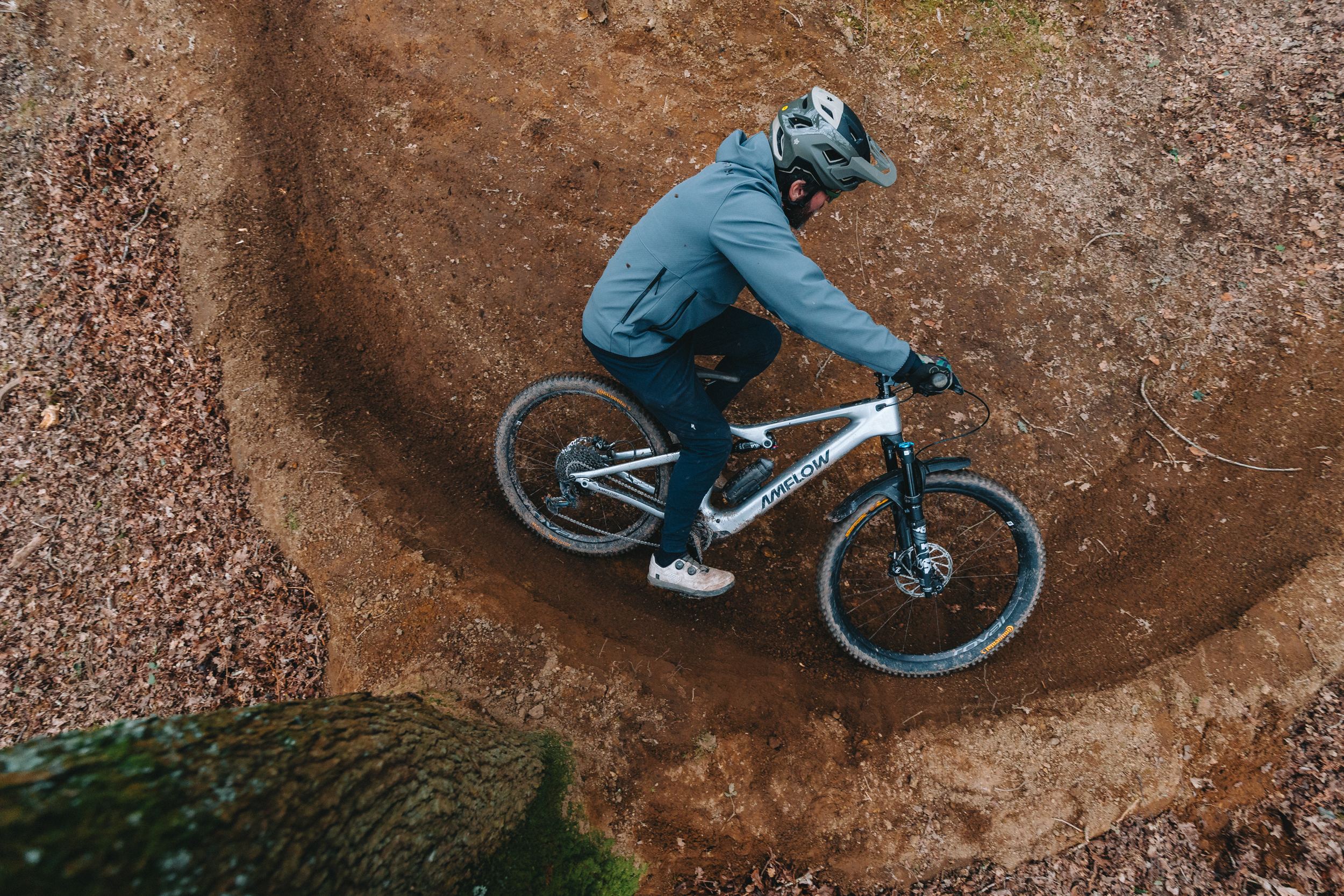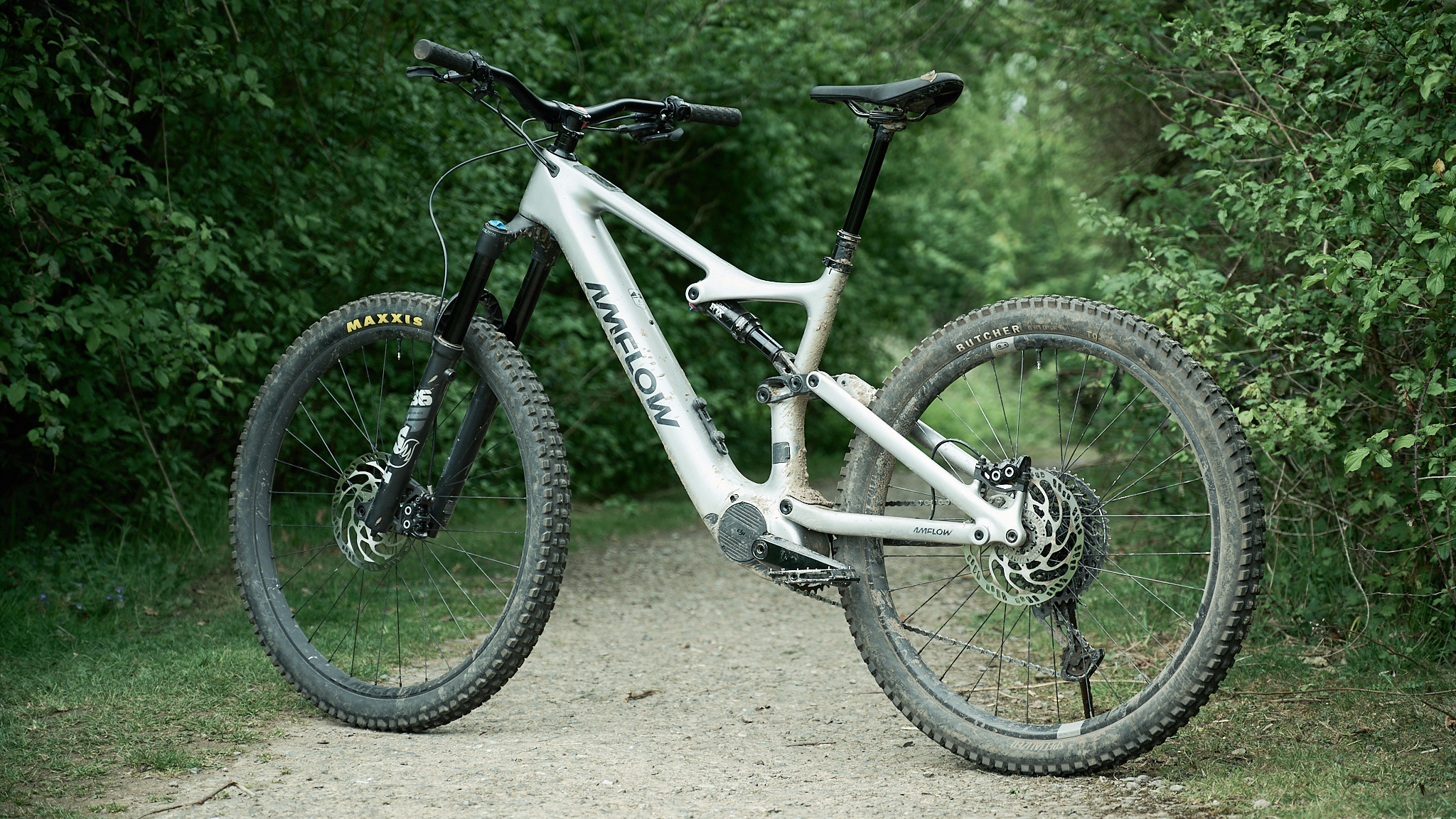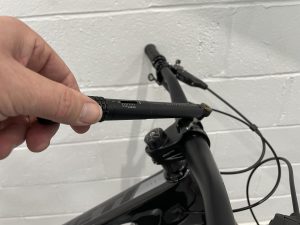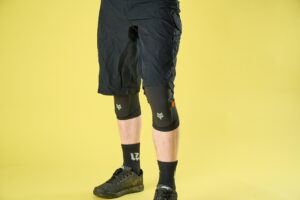Amflow's PL Carbon is not flawless, but for a first effort, it's an impressive e-bike, and for £6k the power delivery, weight and handling are simply unbeatable.
I’m a professional bike tester, and while the DJI-powered Amflow PL Carbon isn’t perfect, it’s the only e-bike I’d buy with my own money
It’s fair to say that the Amflow PL Carbon is the most exciting e-bike of 2025. Not only that, it’s the only e-bike I’d happily spend my own cash on. And not just because it’s the most powerful. Although, with the cutting-edge DJI Avinox motor now boasting 1,000 watts peak power and 105Nm torque in Turbo, the Amflow simply blows the doors clean off any other e-bike currently available powered by Shimano, Bosch, Brose, Yamaha, SRAM or any of the other best e-bike motors.
– Short of time? Click here to skip to the verdict –

Designed around the DJI Avinox M1 Drive Unit the Amflow delivers impressive numbers.
Okay, so the new S-Works Specialized Turbo Levo cranks out 720 watts, so it’s getting closer, but stick the Amflow in Boost and you get 1,000 watts peak power and 120Nm torque for an eye-watering 30 seconds of pure unadulterated speed. Which is insane.

Less than 12 months ago, no one had heard of Amflow, now everyone is talking about the brand.
Factor in the impressive 21.52kg weight for a £6k e-bike with an 800Wh battery, fast-changing and a decent specification, and it’s easy to see why the Amflow is flying off the shop floor just as quickly as it’s flying up hills.

The Amflow PL Carbon changes everything, and at the same time the fundamentals remain the same.
In fact, most reviews of the Amflow tend to focus on the DJI motor and its incredible power output, even if that’s just one part of the puzzle. What I wanted to know is if the Amflow is as good an e-bike as the DJI electronic tech adorning it? Or if it’s just the eMTB equivalent of a muscle car? Great in a straight line, but useless in the twisties. I also wanted to figure out why everyone was saying: “it’s just a trail bike.”

The first upgrade on the Amflow was to fit softer compound, DH casing tyres.
So in an attempt to answer those questions, I ditched the stock tires and wedded myself to the Amflow for five full months. We went on vacation together over Christmas to Italy, where I smashed it up and down high-speed rocky coastline trails in Tuscany. Back in the UK I took it on regular day trips to the dark, dank valleys of South Wales, enjoyed loamy and dusty spring sessions in the Surrey hills, and bike park laps in a wide range of conditions. I also ran the battery flat for a comprehensive range test of the Amflow, and attempted climbs that I thought impossible and impassible, all in the name of testing. So here are my unfiltered thoughts on the Amflow PL Carbon.

Anflow and DJI have clearly raised the bar, but does the PL Carbon deliver as a whole?
Amflow PL Carbon need to know:
- Lightweight e-bike fitted with ultra powerful DJI Avinox motor
- Full carbon frame with 150mm travel and 160mm fork
- Turbo mode delivers 105Nm torque and up to 1,000W power
- Integrated 800Wh battery weighs 3.74kg
- Fast charging takes battery from 0 to 75% in just 1.5 hours
- Top tube mounted 2in OLED touchscreen display, with two wireless controllers
- Four power modes Eco, Trail Turbo, Boost, plus ‘intelligent’ Auto mode
- Comprehensive motor tuning with DJI Avinox app
- Complete bike weighs 21.52kg (47.44lb) size L
- Four frame sizes: M, L, XL, XXL
- Bike comes stock with 29in wheels
- Rocker link flip chips correct geometry for 27.5in rear wheel
- Available online or through dedicated Amflow dealers
Frame and geometry
Let’s start with sizing. There are currently four frame options available on the Amflow, medium to XXL. That’s right, there’s no small size. And that’s probably because the long, slender, 800Wh battery, that’s housed inside the full carbon frame, would make it difficult for Amflow to produce a genuine size small frame. At least without switching to the 600Wh battery that’s only offered as an option on the top-end Amflow PL Carbon Pro.

Taller seat towers will penalise shorter rider, also there’s no size small Amflow.
Then there’s the suspension lay-out, which makes it tricky to get a short enough seat tube for a small size frame, at least while retaining enough insertion to run a seatpost with a sensible amount of drop. In fact, one of my major bugbears with the size L test bike is that the 455mm seat tube is simply too tall on a modern 150mm travel bike.

You’ll be dragging bars and pedals on the Amflow with the modified geometry.
My other concern with the geometry, and this is a big one –at least for me – is that the 341mm bottom bracket height feels too tall for confident descending. Especially given that the bike comes with short 155mm cranks, so pedal clearance really isn’t an issue. And the key thing here is that it “feels” tall when you ride. And that’s actually way more important than the static BB height measurement.

Not the stock rear wheel. I went MX and did not correct the geometry.
Fortunately there’s a relatively easy fix. By swapping the stock 29in rear wheel for a smaller 27.5in wheel, I was able to drop the BB height down from 341mm to 327mm, which is 2mm lower than the Whyte ELyte 150 Evo Stag Works that I tested recently. The move to an MX wheel setup – without using the flip chips in the rocker link to correct the geometry – also lops one full degree off the head angle, to make the bike a slack 63º enduro weapon.

Flip chips in the rocker link can correct the geometry for a 27.5in rear wheel.
Now, I’ve noticed that some of the e-bike influencers have been fitting longer travel forks to their Amflows to make the bike more capable. And while this mod will give you more fork travel and a slightly slacker head angle, it kinda defeats the purpose, as the taller forks also raise the BB height further. So if you want to make your Amflow more capable, simply fit a 27.5in rear wheel and do not touch the flip chips. Also you’ll need to correct the wheel size of the speed sensor in the DJI Avinox app, otherwise the motor will cut out before reaching the 15.5mph (25kmh) assist limit.

With 445mm chainstays the Amflow has balanced weight distribution.
BB height aside, I’ve been really happy with the rest of the Amflow geometry. The 470mm reach is spot on for a size large e-bike and a good fit for me at 181cm tall. And while the 445mm chainstay length isn’t crazy long, it offers a good balance between keeping the front end down on steeper climbs and allowing you to load the front tyre easily on flatter turns, while still making it easy enough to pop the front end up at a moment’s notice.
So to recap. I’d like the Amflow to come stock with a lower BB height and a shorter seat tube. And if Amflow really wants to impress on the scales, MX wheels as standard help reduce the overall weight too.
Motor and Display
This is where the Amflow really stands out. The compact DJI Avinox motor weighs only 2.52kg and cranks out 850 watts peak power (now 1,000 watts with the latest firmware update). That means that the DJI motor is only 500g heavier than the lightest SL systems that were in our SL E-bike of the Year test, but can still deliver almost triple the power output. It’s why DJI has single-handily redefined what an SL e-bike should be. Or, to look at it from the opposite direction, where full power e-bikes are headed.

The 800Wh battery is non-removable, but you do get fast charging as standard.
Weight was clearly the focus with the Amflow, and by using high density cells, the streamline 800Wh integrated battery weighs in at 3.74kg. Having an integrated battery, rather than a removable one, is going to be a deal breaker for some, but with fast charging and more affordable portable power packs from the likes of Atom ESS becoming available, charging on the go has never been easier.

Not one, but two wireless controllers, both of which can be removed.
Two wireless handlebar remotes let me toggle between the five power modes; Auto, Eco, Trail, Turbo and Boost, and switch between the different screens of the 2in OLED toptube mounted display. There’s also a walk mode, and the motor has Auto Hold and Hill Start Assist to make it easy to get going again if you stall on a climb.

Touch screen, crystal clear and fully customisable OLED display.
The screens, modes, assistance… basically everything electronic is pretty much customisable in the DJI Avinox app. You can even connect a DJI Action 5 Pro POV camera to one of the controllers, or ditch them completely and just use the touchscreen display.

With 42 pick-up points, the DJI Avinox motor has very accurate wheel speed data.
At the opposite end of the bike is the speed sensor. It’s magnetic, but this hall ring sensor is taking 42 speed readings with every revolution of the wheel. That gives the DJI motor the most accurate wheel speed information available. And while it’s not there yet, the next step for DJI has to be some form of traction control.
Charging
The Amflow PL Carbon comes with the same 12A/508W fast charger that you get with the more expensive Pro model. So, if you do the math, you’ll see that you can charge the stock 800Wh battery from flat to fully charged in under 2 hours. Or to look at it another way, Amflow says that you can go from zero to 75% change in 90 minutes. Handy when you forget to charge it the night before a ride like I did. One concern with fast chargers is that they compromise battery longevity, but Amflow states that the battery will still have 80% of its initial capacity after 500 full charge cycles. So you’d have to completely rinse the battery every single day for a year and a half to get to that point, and you’d still have 640Wh battery capacity.

Clean as a whistle, the charging port cover is spring-loaded and closes automatically.
What’s really cool though, is that every time I plugged the Amflow in to charge, the display told m exactly how long it’s going to take to charge the battery to 100% capacity. Also, unlike the Bosch Smart Charger on the Whyte E-Lyte 150, it’s really obvious which way round the charger goes into the changing port, so I never had to fumble around in the dark trying to connect it. And when I was done charging, I could simply pull the charger cable out and the protective door covering the charging port closed automatically, so I didn’t need to remember to do it. Genius, right?. Also if you fit a sim card to the top tube display, you can see the charge status on your phone from the comfort of the sofa, and, more importantly, know exactly where your bike is at all times.
Suspension
This is where the PL Carbon gets interesting. Amflow clearly hasn’t tried to reinvent the wheel when it comes to the frame layout or suspension. As such, the Amflow uses a standard four-bar suspension layout, which is not that dissimilar to a Gen 1 Specialized Levo SL. Claimed frame travel is 150mm, and in the workshop I measured the vertical rear wheel travel at 148mm, which would easily become 150mm when measured along the curve of the axle path. Speaking of curves, I also ran the numbers for the anti-squat and anti-rise, and again the suspension layout on the Amflow is very neutral.

Trunnion mount Fox Float Performance (185x55mm) shock needs fine tuning.
That doesn’t mean the rear suspension on the Amflow is normal though. I’ve tested enough bikes with 55mm stroke shocks and similar amounts of travel – most of the bikes in my SL e-Bike of the Year test – in fact. So I know that 200psi is a good starting point for my 81kg weight. But that proved to be way too firm on the Amflow, creating an overly harsh and fatiguing ride. Now, if this were a one-ride review, I could easily have jumped to the wrong conclusion about the bike.

Run the shock too soft to reduce the BB hight and you’ll quickly hit the bump-stop.
Thankfully it isn’t. In fact, it was just the beginning. My process of setting up the suspension started with repeated runs on the same trail in Italy, dropping the shock pressure 5psi at a time. And that’s the real beauty of e-bike testing, repeated runs for setup are super easy and repeatable. Going softer instantly made the suspension and handling feel much better, and I went all of the way down to 160psi, which is crazy low for my weight. Surprisingly, it’s actually Amflow’s recommended pressure for an 80kg rider, at least on this model. At that pressure the shock bottomed way too easily, and because I ended up hitting the big Fox bottom-out bumper inside the Performance level Float shock more frequently, the ride actually got appreciably harsher at the lower shock pressures.
So I did a quick about turn and started going up in 5psi increments, before settling on 175psi, which equates to roughly 35% sag on the shock, with all of my weight resting on the saddle. So still pretty soft. Now, I should point out that I was still on the full 29in setup at this point, so the high degree of shock sag really helped reduce the BB height. Again, suspension is all about dynamic behaviour, and the bike felt better with the increased sag.

It took time to get the rear suspension on the Amflow PL Carbon just so.
At 175psi, I’d only touch the bump stop occasionally on drops or really big impacts. But the shock was soft enough to keep the bike composed at speed, or on anything steep where I was dragging the brakes a lot. It’s also interesting that Amflow has higher recommended shock pressures for the Fox Float X equipped PL Carbon Pro that Danny rode. So there’s clearly work to be done on Amflow’s recommended suspension settings.
With the sag and rebound damping to my liking, I spent the next few days hammering around on the Amflow just to get comfortable on the bike. As each day passed, my speed increased and the suspension felt better and better, where the tendency for the rear end to break traction on hard-packed, off-camber sections had completely vanished.

Expensive doesn’t always mean better. I preferred the suspension on the entry-level PL Carbon.
In fact, I couldn’t help thinking that the Amflow was so much more capable than the trail bike category it has been pigeonholed into. And for reference, I’ve mostly ridden analogue enduro bikes on my Xmas vacations in Italy over the past 10 years, and the Amflow felt as capable as any I’ve tested.
With one major caveat; don’t run the tyres too hard. That improvement in grip and suspension feel that I’d noticed was partly down to a slight drop in tyre pressure that occurred over three days straight riding. Once I corrected the tyre pressures, the back end’s inclination to step out instantly returned, and I put that down to the frame, or possibly the alloy wheels being overly stiff.
Yes, you read that right. The Amflow PL Carbon is a solid bike. With tougher DH casing tyres fitted, it’s 100% enduro capable, and can be ridden really hard. I know, I know… nearly everyone else who has reviewed the Pro model has said “it’s just a trail bike” but the bike I’ve been testing is so much more than that.
Now, I’ve been doing this long enough to understand how a shock, or specifically a shock tune, can really transform the suspension and handling of any bike. So when I got back to the UK, I asked Amflow to send me the Fox Float X Factory shock from the Pro model to try on our PL Carbon test bike. And to be honest I didn’t really know what to expect, but when the bike sounded different just riding to the trailhead I knew something was up.

Fitting the Fox Float X shock impacted how the fork felt too.
In back-to-back testing, the Fox Float X Factory shock from the Pro model felt like it had a distinct platform in the compression. And this extra degree of firmness in the rear suspension robbed the bike of traction, transmits more vibration to the rider, and gives the bike less confident handling, both front and back.
In short, it made the suspension less effective and the bike more “trail-bike-like”. So, to be crystal clear, if you want to ride your e-bike hard, or more like an enduro bike, the entry-level Amflow has way better rear suspension than the PL Carbon Pro. Is the stock suspension perfect? No, I’m convinced there are still performance gains to be had with a custom tune, but it’s 90% of the way there.

The 160mm Fox 36 Float fork feels well balanced with the rear suspension.
Now, at this point, I should probably mention the fork. The basic 160mm travel Fox 36 Performance unit is smooth and plush, even if it lacks the support of the Grip 2 and newer Grip X forks from Fox. It feels well balanced with the rear suspension on the PL Carbon, and does a better job of isolating the rider from high frequency impacts than the more expensive Fox forks. The trade-off is that I didn’t get the same amount of support, so I needed to run my handlebar high and my feet low, which is another advantage of the 27.5in rear wheel modification.
Components
If you’ve watched my Amflow unboxing video you’ll know that I expressed my concerns about the Amflow Enduro stem being overly flexy – hardly surprising given it only weighs 102g. But as I’ve already mentioned, the bike feels really solid, so there were only a couple of occasions when the steering felt a little vague, and if anything the flex may actually reduce fatigue on longer, rougher trails.

Full height on the stem even with the 35mm rise alloy bar.
More to the point, I was running the stem at the maximum height, with the stock 35mm rise handlebar fitted. So if anything, the large Amflow would probably benefit from a taller head tube to increase the stack. In fact, a better solution would be a 10mm low BB height, which would allow you to reduce the bar height by 10mm, while maintaining the same overall position on the bike. Again we come back to the 27.5in rear wheel, with zero geometry correction.

The Magura MT5 brakes have plenty of power and proved 100% reliable.
After having multiple issues, and a couple of really scary moments, with the Magura MT5 brakes on the Cannondale Moterra SL that I reviewed, I was more than a little apprehensive about taking the Amflow to Italy with the stock Magura MT5 brakes. But, I needn’t have worried as the addition of the Magura HC lever blades stop the levers from flicking out accidentally from under my fingertips. And the overall feel of the MT5 brakes, with the 203mm MDR rotors, is positive and powerful. In fact, in five months of use they have been 100% reliable. No bleeding or inconsistent lever feel. I just wish I could say the same of most of the new SRAM brakes that I’ve tried.

If you run your brake levers flat, you’ll want a separate shifter mount.
The brake setup on the Amflow isn’t perfect though. And as neat as the integrated Magura Shiftmix 3 lever clamp looks, I’d much prefer a separate mount for the 12 speed SRAM GX shifter, as I just couldn’t get the shifter pod exactly where I wanted it. Basically, if you run your levers flattish, the shifter pod rotates too far under the bar, which makes it hard to reach. And the funny thing is, I only really noticed this when riding the Amflow in the UK, where I had to shift gear more often than on the winch-and-plummet trails in Italy.

Even with the mechanical SRAM GX drivetrain, the Amflow instantly knows which gear you’re in.
Shifting performance of the SRAM GX mechanical drivetrain is solid and precise, and in my experience the SRAM GX derailleur is more robust that Shimano XT or equivalent. Which is a good thing on a bike with so much power. The gear range on the SRAM NX cassette is 11-50t, so not as wide as the 10-52t cassettes you see on a lot of e-bikes, but more than adequate given all the power.

More power means you use fewer gears, well at least until you run out of battery.
Well, at least until you get to 10% battery and go into eco mode at the bottom of a steep valley. Then, and only then, will you wish you had a 52t cog out back. In the higher power modes the stock cassette is more than adequate, even on steeper climbs, and it will actually be the stock Maxxis Dissector rear tyre’s lack of traction that will limit your performance, not the available gear ratios.

With smart software you don’t need rapid freehub engagement.
But before I get to the tyres, I should point out that the freehub on the Amflow has a seriously sluggish 21t engagement. Now, I’m only highlighting this because someone in the comments of my unboxing video asked me to check it. I’d not notice slow engagement, if anything it’s the opposite; the pick-up on the Amflow is instant. Best of all, it never feels like the motor is going to kick in when you simply rest your foot on the pedal, like on some bikes. So it never felt like the bike could accidentally shoot out from underneath me. Apply pressure to the pedals though, and the Amflow responds instantaneously, with super smooth power delivery. So even with the sluggish freehub engagement, the ample overrun seems to keep the freehub engaged during stop-start pedalling situations. And with the latest firmware update, you can actually adjust the freehub pre-engagement to take up any slack in the chain before pedalling. Smart, right?

The DJI Avinox motor on the Amflow offers next-level performance.
Now for the weakest link in the Amflow build kit – the tyres. It’s not lost on me that Amflow wanted impressive headline weights to match the market leading numbers of the DJI Avinox M1 motor, but when you have 850 watts of power as standard (now 1,000 watts) you need a rear tyre with more bite than the 3C MaxxTerra Dissector to deliver that power through the contact patch.

Soft compound, DH casing Maxxis tyres transform the ride quality of the Amflow.
And given how hard I could ride the Amflow, both up and down hill, the EXO/EXO+ casing combo simply isn’t tough enough for the terrain this bike can tackle. As such, I fitted Maxxis MaxxGrip DH Casing tyres to the Amflow, and it still weighed under 22.5kg. Impressive for an e-bike that sits on the showroom floor for £5,999. Also I should make it clear that, when I’m discussing the performance of this bike, it’s with the DH tyres fitted, not the stock rubber.
Okay, there’s one caveat. For the range test I fitted the same Continental Kryptotal Soft compound tyres that I used in the SL E-Bike of the Year test, just to keep the playing field level. With that set-up, the Amflow managed 1,430m of vertical in Turbo, which breezes past all of the lower power SL bikes.
Granted, the Amflow has not got the same range as the new Specialized Turbo Levo Pro – which managed 1,633mm with the exact same tyres fitted. But then the Levo’s 666 watts peak power in Turbo mode doesn’t come close to the Amflow’s 850 watts. Turn the Amflow down to Trail mode, and I’d expect similar range numbers to the Specialized.

Comfy. But the wider saddle profile rubs your inner thigh with riding dynamically.
Actually, I’d change one more thing. The saddle on the Amflow has too wide a profile so I’d swap it for a narrower one. That or fit a longer dropper post. And it’s not that the saddle is uncomfortable, it’s just that the edges of the saddle are hard and tended to catch on the inside of my thighs when riding really dynamically.

For Amflow’s first e-bike, the PL Carbon has caused quite the stir.
Performance
Up until now this review has been pretty clean cut. I’ve discussed the geometry, suspension, electronic interface and the components mostly in isolation. But an e-bike is only as good as the sum of all the parts, so I’ll try to take a more holistic approach when discussing the overall performance.
Climbing
You can roughly split e-bike climbs and climbers into two camps. And while there’s a growing number of riders that live for the challenge of steep, technical e-bike climbs, I think it’s fair to say that the majority of e-bikers are still in the self-shuttling camp. Where you use the power of the motor to cruise up fire road climbs and preserve more of your biological energy for shredding the fun stuff. And probably the single best thing about the Amflow is that it doesn’t matter which camp you’re in, because it excels at both.

All the power and all of the control means you can conquer all climbs.
Let’s get the easy route to the top out of the way first. With 850 watts peak power, I could blast up fire roads in Turbo or Trail mode without even breaking a sweat. In fact, I’ve noticed that when I’m climbing fireroads on the Amflow with other riders on bikes with less power – basically anyone that’s not on an Amflow – I tend to have a really loose grip on the handlebar, and mostly ride one handed, as this makes it more comfortable to turn round and chat with my riding buddies. And it’s not just me, I’ve noticed other Amflow riders doing the exact same thing.
Also having all of that power on tap, makes it easy to overcome the extra drag of the super soft DH tyres, while still maintaining a blistering climbing pace. Just don’t expect impressive range numbers from the Amflow in the higher power modes. In fact, if you could keep the bike tapped out at 850 watts, in theory you could burn through the 800Wh battery in under an hour. In real terms, I was getting just under 1,400m of vertical and 40km of riding out of a single charge when testing in dry conditions in Italy. And remember that’s with DH tyres.

The hall wheel-speed sensor could be the secret to the Amflow’s incredible uphill grip.
Now for the technical part. Because Amflow uses a Hall ring speed sensor with 42 pick up points, similar to the one Bosch uses for its ABS brakes, the Avinox system is constantly monitoring rear wheel speed, or, more importantly, changes in wheel speed. Now, compare that to a Shimano or Bosch e-bike system where you get one speed reading per revolution of the rear wheel. On a full 29er that means you can ride almost 2.5m before the system takes a second reading. And on a really technical climb a lot can change in that distance.

Go crazy on climbs with Boost mode: 1,000watts with 120Nm torque for 30 seconds.
And I’m convinced that DJI’s ability to process more information, faster and more effectively, is one of the key reasons the Amflow feels like it has traction control on the techy climbs. Which is hardly surprising given that DJI can make autonomous drones that pretty much fly themselves, all while keeping a camera perfectly stable.
But it’s not the only reason the Amflow is the current undisputed mountain goat of technical climbs. Having the power and torque on tap meant my gearing and cadence could be lower than normal, which makes the bike much easier to control, especially when traction is inconsistent. The motor also has a nice degree of overrun, but unlike the Bosch CX Race, or Askoll motors, it never seemed to push me ahead, when I actually needed it to back off. In short, the DJI Avinox M1 Drive Unit is an intelligent system that meters its unrivalled power incredibly well.
Descending
If you haven’t skipped ahead to this section, it should be crystal clear that the Amflow PL Carbon is the undisputed king of climbs. But how does it perform on the descents? Given that a lot of reviewers have stated that the top-end Amflow PL Carbon Pro is flexy and feels like a trail bike, I was expecting the entry-level Amflow PL to feel the same, especially given that I was primarily testing it on enduro trails in Italy.

Load the Amflow PL Carbon hard in a turn and there’s zero unwanted flex.
Now this may come as a surprise, and it certainly surprised me, but the entry-level Amflow is anything but flexy. In fact, I’m going to contradict every other review of the Amflow, as I actually think the carbon frame and alloy wheels are pretty stiff. This was most evident when running slightly higher tyre pressures, as it causes the rear end to step out on off-camber sections. I thought that swapping to a smaller 27.5in wheel would exacerbate this issue, but it actually helped. As the lighter wheel with thinner spokes had a bit more flex in it.

Lightweight, playful and capable, the Amflow PL Carbon does it all.
And I can’t stress enough how changing to the smaller rear wheel transformed the geometry, handling, and confidence of the Amflow on steeper descents. With the tyres upgraded and the 27.5in rear wheel installed, the Amflow effortlessly blurred the line between enduro and trail. It’s still easily light enough to chuck around, but the riding piston gave me the confidence to ride steep, fast, or technical terrain with poise and complete control. Yes, the slack/low setup makes the seat tube angle a little slacker too, so it does nothing to improve the bike’s climbing prowess, but you can always shove the saddle forward on the rails to compensate. Also, given that the Amflow smokes every other bike uphill, it can easily absorb some losses on the climbs to make it better on the descents.

Amflow and DJI are redefining what’s possible on an e-mtb and others will follow
Verdict
Testing e-bikes is tricky. You have to assess the performance of the electronics, the ride quality of the bike, the components and how everything interacts as a whole. And while it’s clear that the DJI Avinox Drive Unit is currently unrivalled in terms of weight, power, integration and performance, the Amflow PL Carbon as a bike isn’t perfect. It’s really close though. With better tyres, a narrower profile saddle and a separate mount for the SRAM mechanical shifter, the specification would be dialled straight out of the box. Harder to remedy are the shortcomings in the frame geometry. With relatively tall seat tubes across all four frame sizes it will be difficult for riders with shorter legs to achieve a perfect fit on the Amflow. That wasn’t really an issue for me, and by fitting a 27.5in rear wheel I found a workaround for the BB height that I was really happy with. The smaller rear wheel even saves some weight on what is already a really light full-power e-bike. So the Amflow PL Carbon isn’t perfect, but as a professional bike tester it’s still the e-bike I’d buy with my own money. And that’s because I simply love the power and control the DJI motor offers. By modifying the geometry with a 27.5in rear wheel, I achieved a riding position on the Amflow that’s as good as any other e-bike I’ve tested. But what really seals the deal for me is the price. E-bikes are expensive, even £6k ones, and the Amflow PL Carbon delivers a level of motor performance that’s not currently available at any price point.















